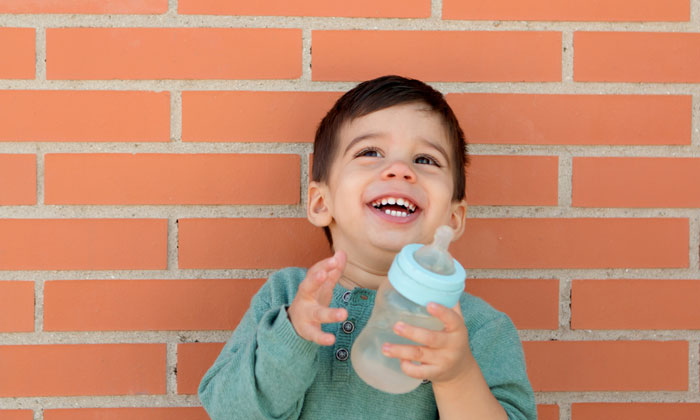Tetra Pak on the importance of subsidising a child’s milk intake
- Like
- Digg
- Del
- Tumblr
- VKontakte
- Buffer
- Love This
- Odnoklassniki
- Meneame
- Blogger
- Amazon
- Yahoo Mail
- Gmail
- AOL
- Newsvine
- HackerNews
- Evernote
- MySpace
- Mail.ru
- Viadeo
- Line
- Comments
- Yummly
- SMS
- Viber
- Telegram
- Subscribe
- Skype
- Facebook Messenger
- Kakao
- LiveJournal
- Yammer
- Edgar
- Fintel
- Mix
- Instapaper
- Copy Link
Posted: 26 April 2017 | Roy Manuell (New Food), Stefan Fageräng | Managing Director North West Europe | Tetra Pak | No comments yet
Stefan Fageräng, Managing Director North West Europe at Tetra Pak offers New Food an insight into why we must ensure children consume enough milk.


- Could you describe for us the purpose and findings of the recent report that we understand to have also been cited in UK parliament regarding children and milk intake?
It is becoming increasingly important for the industry, government, and the public to look at how we can work together to tackle the issue of childhood obesity. More than one in five children are overweight or obese during their first year of primary school in England, Scotland and Wales, according to the Royal College of Paediatrics and Child Health. This rises to more than a third by the time they start secondary school, a worrying trend and one which we all need to work together to reverse.
Children need a healthy balanced diet and while parental responsibility is key, encouraging healthy eating in schools is fundamental to tackling this one piece of the puzzle too. Milk is a rich source of protein, calcium, Vitamin B12 and iodine, meaning that access to school milk is, and should continue to play a key role in helping to deliver a healthier future.
Our Making More of Milk report, developed in consultation with industry groups, explores the role of school milk, the drinking habits of children in schools and considers ways government, school milk providers, schools and parents can increase milk uptake and remove some of the stumbling blocks preventing greater consumption of milk at primary school.
Our independent research of 1,000 parents of primary school children and 500 nursery or reception teachers revealed that only 55% of primary school-aged children in the UK are drinking milk in school.
Meanwhile, just over a quarter of parents (28%) say the main reason their kids are not drinking milk in school is because they are unaware their children are eligible for free or subsidised milk.
However, there is overwhelming support for free school milk, with 89% of parents and 93% of teachers saying all children in Reception should be eligible for free school milk, including if they are above the age of five. The current model cuts access to free school milk at the age of five, making it complicated for teachers to administer and unfair on those children who suddenly, half way through their school year, are unable to drink milk free of charge.
Our report, which was referenced in a recent UK parliamentary debate, makes three recommendations:
- Maintaining the availability of free school milk in the future and ensuring it is made available for all Reception children in England for the complete school year (and access is not cut off when children turn five);
- Encouraging schools to make milk available throughout the school day. The research found that currently 30% of teachers say their school is not making low fat milk available at least once a day, despite guidance to do so included within the School Food Standards. This highlights that policymakers should also examine ways they can encourage and support schools in complying with the relevant regulations, without adding administrative burden;
- Promoting education by ensuring all nurseries and schools are communicating to parents, children and teachers about the recommended types of milk, daily portion sizes and benefits of milk. With 28% of parents saying the main reason their children are not drinking milk in school is because they are unaware that their children are eligible for free or subsided milk, they should also be provided with information to improve awareness about their right to ask for free or subsidised milk and how they might easily be able to secure this for their children.
- Why is free and subsidised school milk so important?
The health benefits of milk for children have long been at the forefront of the UK Government’s healthy eating strategy. Low in sugar, yet high in nutrients, milk offers many of the vitamins and minerals to promote children’s healthy development.
Milk plays a particularly important role in physical development for children and young people. Its high-energy content and high nutrient density is ideal for meeting their high-energy needs and filling small stomachs, while helping them stay hydrated.
With increased public and government focus on healthy eating and drinking, this rich source of protein, calcium, Vitamin B12 and iodine is, and should continue to be, a key part of our children’s daily diet, beyond the requirement of hydration.
With clear links between consuming milk and healthy body mass in children, school milk becomes ever more important, when you consider that obesity prevalence for children living in the most deprived areas is more than double that of those living in the least deprived areas.
Young children under the age of five have been able to enjoy free school milk in the UK thanks to a Nursery School Milk scheme since the 1940s, and a European fund has reduced the price of school milk for children up to the age of 18 since 1977.
However, consumption is lower than it should be even amongst pre-schoolers, and this uptake falls beyond this age, especially in children aged nine and older.
School milk needs to be safeguarded and policy best practice shared across different parts of the UK to encourage greater uptake, make it ‘cool’ to drink and protect the future health of our children.
- On a more general note, just how significant an issue is child obesity?
At a macro level, food and drink is more plentiful and cheaper to buy than ever before. People are leading more sedentary lifestyles and obesity rates are rising. By the Government’s own estimations, nearly a third of children aged 2-15 years are overweight or obese and younger generations are becoming obese at earlier ages, which is very concerning not only for the health of the nation, but its economy too.
Obesity is a serious and complex problem, involving people consuming too many calories, doing too little exercise, and not making the right choices. Although there can be no single ‘silver bullet’ to solving the current health and obesity challenge, collaboration is key and there are areas where industry, government, and health experts can and must work in partnership to deliver positive change.
- What other solutions are there for ensuring that UK children have the correct nutritional intake?
It is important to keep a balanced approach. Not all children are obese or overweight and young children need a nutritionally dense diet to fuel growth and the physical activity their bodies need to remain healthy. Already the Government’s Childhood Obesity Plan for Action, published in August 2016, states children need to be doing at least thirty minutes of sport and physical activity a day in schools.
Measures outlined in the Childhood Obesity strategy, will also lead to renewed focus on schools’ approach to encouraging healthy eating. Each year, £10 million of that levy has been committed to the provision of healthy breakfast clubs at schools. It’s also encouraging to see that the Government has announced plans to rate schools’ contribution to preventing obesity during Ofsted inspections as well as updating School Food Standards to reflect new advice on sugar and nutrition.
Industry is already responding positively by delivering healthier, more convenient solutions that are portion controlled, contain less sugar or deliver more nutritional benefits to both children and adults alike. Some businesses are already using innovative approaches such as appealing pack design or clear labelling to encourage children and their parents towards healthier choices too.
This becomes key as there is a clear link between eating healthily, balanced diets and a lower prevalence in weight gain. It is essential that school milk is safeguarded and policy best practice shared across different parts of the UK to encourage greater uptake, and protect the future health of our children.
Policymakers should examine ways they can encourage and support schools in complying with the relevant regulations further. For example, 30% of teachers say their school is not making low fat milk available at least once a day, despite guidance to do so included within the School Food Standards. Closing these gaps, without creating new administrative burdens, could immediately deliver health benefits to children.
We can also see a need for more guidance to parents on what they should be giving to their children and in what amount, with more readily available solutions for use both at home and in their lunchboxes.
- What does 2017 look like for Tetra Pak?
This is an exciting year for the business as a strong focus on health naturally lends a greater need for packaging, like cartons, that offer greater protection for the nutrition content, taste and quality of the product packed inside.
We recognise how important it is to start healthy eating habits at an early age, at home and at school, in order to encourage the right lifestyles and choices for a healthy future for our children.
Therefore, this year, we plan to focus on healthy eating and nutrition in primary schools. Whilst milk forms an important part of a child’s diet at school, there are a host of other nutritional needs that should be considered.
Lunchboxes for example, do not have to follow nutritional guidelines in the same way that school-provided lunches do and many parents struggle to include nutritious food in their child’s lunchbox; and even if they can, they have little control over whether their child eats what they are given.
Our focus is on how we can support schools, parents, the Government, and industry bodies to provide healthier choices for children too.
- What sort of an impact do you envisage Brexit might have on the UK food and beverage sector?
It is hard to predict the impact it will have across the entire food and drink sector, but it immediately raises questions on the effect it might have on the future of free and subsidised milk across schools in both the medium and the long term.
Ofsted-registered schools are currently able to take advantage of the EU’s School Milk Subsidy Scheme, which aims to encourage children across the EU to develop a lifelong habit of consuming milk and milk products for the long-term health benefits they bring. The UK Government has committed to match any shortfall from the loss of this subsidy up to 2020, resulting from Britain’s departure from the EU.
In a recent debate, Education Minister Edward Timpson confirmed that the Government will, “carefully consider how we will continue to support schools, so that we can fulfil our obligation to provide children with a healthy and balanced diet… the fact that we can go back to the 1940s to see how Governments have provided help and support in this area is an indication of where we may want to take the evidence in future.”
Whilst we do not know yet what the exact policy will be, we welcome the Government’s continued support for school milk as a key part of childhood nutrition, and look forward to working constructively with the Government and other stakeholders on protecting the future of school milk and making more of school milk programmes in future.









